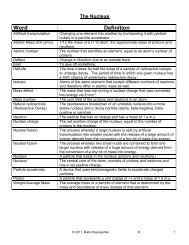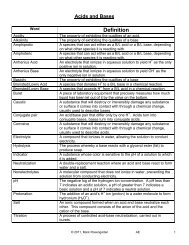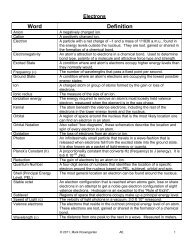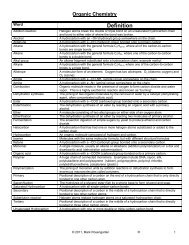Unit 5 - Mark Rosengarten
Unit 5 - Mark Rosengarten
Unit 5 - Mark Rosengarten
You also want an ePaper? Increase the reach of your titles
YUMPU automatically turns print PDFs into web optimized ePapers that Google loves.
The number of valence electrons that an atom has determines its physical and chemical properties.<br />
It will explain most of the things you will be learning about for the rest of the course.<br />
LEWIS DOT DIAGRAMS - using dots in groups of 2 around the symbol of the atom to represent the valence<br />
electrons. For every atom you are responsible for, the valence electrons will occupy only s and p orbitals. The<br />
s electrons fill up first, then the p electrons fill, up electrons first, followed by the downs, just like in the box<br />
diagram.<br />
Element Shell Config # Valence Electrons Lewis Dot Diagram<br />
Li 2-1 1 (one s electron)<br />
Be 2-2 2 (two s electrons)<br />
B 2-3 3 (two s electrons and one p electron)<br />
C 2-4 4 (two s electrons and two p electrons, ups go in before<br />
downs)<br />
N 2-5 5 (two s electrons and three p electrons, ups go in<br />
before downs)<br />
O 2-6 6 (two s electrons and four p electrons, ups are all in, so<br />
go back and put in the downs)<br />
F 2-7 7 (two s electrons and five p electrons, ups are all in, so<br />
go back and put in the downs)<br />
Ne 2-8 8 (two s electrons and six p electrons, all orbitals filled)<br />
KERNAL - the atom underneath the valence shell. This includes all of the non-valence electrons and the nucleus.<br />
This part of the atom has no part at all in chemical bonding (making compounds).<br />
Significance Of Valence Electrons In The Design Of The Periodic Table<br />
The elements on the Periodic Table are arranged in order of increasing atomic number. In 1869, Dmitri Mendeleev,<br />
the designer of the Table, noticed that every so often, as atomic number increases, elements will come up that have<br />
similar chemical properties to elements that came before. He put these elements in the same vertical column, or<br />
GROUP. All elements in the same group share very similar properties to each other. Later, it was discovered that all<br />
of the elements in the same group have the same number of valence electrons, and form ions with the same charges.<br />
Stable Octet: eight valence electrons. Every atom on the Periodic Table will gain or lose enough electrons so that<br />
they will end up with a stable octet. Noble gases already have a stable octet, which is why they do not react with any<br />
other element.<br />
© 2011, <strong>Mark</strong> <strong>Rosengarten</strong> R 14
















